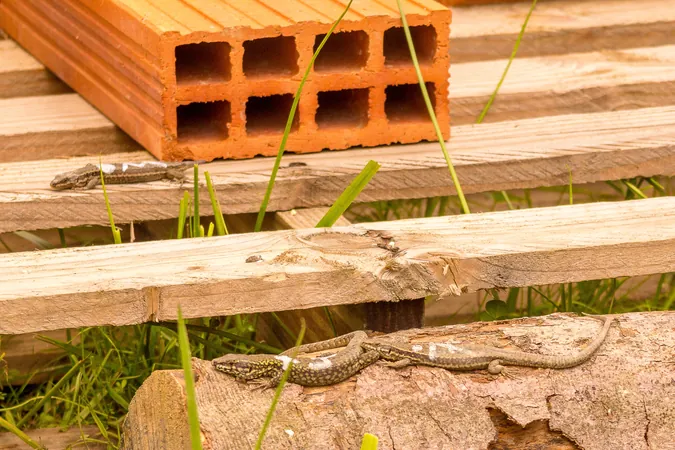
Breakthrough Study Reveals How Wall Lizards Outsmart Rivals in Territorial Battles!
2024-09-27
Introduction
A groundbreaking study featured in *Behavioral Ecology* has unveiled that male wall lizards possess a remarkable ability to resolve territorial disputes through specific behavioral signals rather than relying solely on their physical attributes like size and coloration.
Key Findings
Researchers observed that while darker male wall lizards tend to display more aggression and frequently emerge victorious in conflicts, their hue does not meaningfully influence the reactions of rival lizards. Instead, behaviors such as hunching up and throat extension serve as a display of readiness to engage in combat, while specific foot shakes signal submission to avoid confrontation.
Collaboration and Methodology
The collaborative research team, comprised of scientists from the University of Valencia, Theoretical and Experimental Ecology Station (SETE) in Moulis, France, and the University of Turku in Finland, conducted experiments with 180 common wall lizards (*Podarcis muralis*) in controlled artificial enclosures. Their findings suggest that, contrary to what might be expected, aggression is often more correlated with the losing party's signals rather than a straightforward comparison of strength or physical mismatches.
Understanding Territorial Behavior
“Natural scientists have long been puzzled by males’ reluctance to fight to the death despite competitive pressures for resources,” shares lead researcher Javier Abalos from the University of Valencia. “The dynamics of these interactions often resemble a theatrical performance rather than an all-out brawl. Both animals stand to lose in a physical fight, so it’s beneficial for them to use signals and displays to manage disputes without resorting to harmful confrontations.”
Aggression vs. Physical Characteristics
During the research, it became evident that the timing of aggression displayed by lizards is not necessarily tied to their rivals' physical characteristics. Instead, weaker individuals often persist in confrontations until reaching a self-defined threshold, regardless of their opponent’s strength.
Complex Signaling in the Wild
Interestingly, the lizards utilize a mix of permanent coloration, such as a European robin’s orange chest, which indicates fixed traits like size and strength, alongside flexible behavioral displays that communicate mutable characteristics like their motivation to engage in a fight. This study examined how these two forms of signaling interact during contests among male wall lizards.
The Role of Body Language in Competitions
As the spring sun warms the Pyrenees, male wall lizards are seen engaging in fierce competitions for prime sunbathing locations, ideal crevices for hiding, and food-abundant vegetation. The males put on a captivating display of signals, from revealing colorful patches to conducting elaborate body movements.
“Male wall lizards demonstrate various forms of body language and posturing. They often adopt raised-body positions, extend their throats, and perform rapid, distinctive foot shakes,” explains Enrique Font, another researcher from the University of Valencia. “Our study set up environments specifically designed to provoke these territorial behaviors, revealing deeper insights into their social dynamics.
Female Preferences and Mating Success
Results showed that the majority of females favored high-quality territories, while males occupying these prime spots were more successful in fights (winning 80%), interacted more with females, and fathered more offspring compared to their counterparts in lower-quality areas.
Behavioral Strategies Over Color Patterns
The behavioral strategies employed during confrontations proved to be far more influential than fixed color patterns in determining outcomes. Although darker lizards exhibited more aggression, their coloration did not deter rivals effectively.
Coloration and Contest Outcomes
Curiously, UV-blue patches on their bellies, associated with bite force and visible through a lizard’s vision, appeared to have little impact on the contest outcomes, suggesting these colorations may play different roles such as indicating sex or maturity. This understanding enhances our knowledge of how lizards assess potential threats before initiating contests.
Conclusion and Implications
The study concluded that displays of raised body postures significantly increase the likelihood of winning a confrontation, while foot shakes reduce the risk of physical retaliation after a retreat. This dual signaling reinforces the understanding that wall lizards navigate social interactions with a level of complexity often overlooked.
“Our findings prompt a re-evaluation of how we perceive animal behavior,” admits Fabien Aubret from SETE. “It reveals that animals, including lizards, engage in real-time assessments of each other's intentions rather than relying solely on fixed traits.”
The research team's endeavor is to reshape public perception of lizards from rudimentary creatures to sophisticated social beings, capable of nuanced interactions. “Lizards alternate between roles of resident and intruder daily, employing a richly communicative set of signals. This sophisticated behavioral repertoire is just the beginning of what we can understand about lizard social life,” concludes Abalos.









 Brasil (PT)
Brasil (PT)
 Canada (EN)
Canada (EN)
 Chile (ES)
Chile (ES)
 España (ES)
España (ES)
 France (FR)
France (FR)
 Hong Kong (EN)
Hong Kong (EN)
 Italia (IT)
Italia (IT)
 日本 (JA)
日本 (JA)
 Magyarország (HU)
Magyarország (HU)
 Norge (NO)
Norge (NO)
 Polska (PL)
Polska (PL)
 Schweiz (DE)
Schweiz (DE)
 Singapore (EN)
Singapore (EN)
 Sverige (SV)
Sverige (SV)
 Suomi (FI)
Suomi (FI)
 Türkiye (TR)
Türkiye (TR)